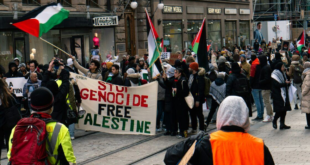Whether it be mothers who lost their sons in combat or other Shiites whose homes were destroyed in Israel’s blitz of Beirut a year ago, Hizbollah is still riding high on its home turf.Two sisters, Loyal and Iman Shahrur, aged 20 and 21, are keen to stress it was Hizbollah that helped find them work and a new home.
Thousands of apartments, like their former home in the Haret Hreik district of the Shiite group’s stronghold in the southern suburbs of the Lebanese capital, were razed to the ground in the 34-day Israel-Hizbollah conflict which erupted on July 12, 2006.
The young women moved into a ground-floor apartment in September, with a year’s rent of $4,000 paid by Hizbollah.
Iman was out of work for three months, surviving on a subsidy from the Iran-backed group, which also covered a younger brother’s school fees.
Loyal, dressed in a black abbaya robe with white embroidery, glances at a giant portrait of Hizbollah’s charismatic chief Sayyed Hassan Nasrallah with tears in her eyes. “Nasrallah, I would give my blood for you,†she pledges.
Across the road, in a third floor apartment, a group of former cocoa traders who have returned from the Ivory Coast show off a large metal triangle which remains from a missile fired by Israeli warplanes.
Their old apartment was flattened, as was the former Hizbollah nervecentre next door where men in black civvies and kitted with walkie-talkies still keep tabs on passersby around a giant crater left behind by the planes.
Half a million people live in and around Haret Hreik, where about 4,000 homes were destroyed in a square-kilometre zone and many thousands more damaged during the war sparked by Hizbollah’s capture of two Israeli soldiers.
The Quleit family of merchants have savings, but that did not stop Hizbollah from handing them $12,000 for a year’s rent and to buy new furniture. “As for the government, nobody here has received a cent,†charges their angry mother.
A government source insists that 4,000 cheques have been paid out, despite long delays due to land registry problems in zones of wildfire development over the decades without any official papers.
The government and its security forces steer clear of the Shiite suburbs, with Hizbollah filling the void.
In the Shiyah area of the suburbs, Fatima, who would only give one name, swears that the death in combat of her son Ahmad, 29, as a “shahid†(martyr) on the last day of the war, which ended with a UN-brokered ceasefire on August 14, was definitely “worth itâ€. Circled by four portraits of the martyr, in glossy print courtesy of Hizbollah, younger brother, Hassan, 21, is proud that Ahmad helped man batteries that rained rockets on the northern Israeli port city of Haifa.
Amid the sea of posters of fallen Hizbollah fighters plastered across the southern suburbs, Ahmad’s picture figures prominently on a wall facing the apartment of his widow.
Hizbollah has a master plan for the suburbs baptised “Waad†(the promise), costing $100 million, officially launched at the end of May. But reconstruction at bombed-out sites has yet to kick off, despite the buzz of repairs which started way back in August.
Teams of architects have drawn up plans for the entire former war zone, to be divided into 30 sectors.
According to Hizbollah’s website, three quarters of the suburbs’ residents have agreed to hand any government compensation they receive over to the group to allow for reconstruction to be carried out on a far more organised basis, with town planning.
While competing with the “Solidere†post-civil war reconstruction in downtown Beirut that was devised by Rafiq Hariri, Hizbollah has in the past also turned down an “Elissar†project for the suburbs proposed on behalf of the government by the slain former premier.
Meanwhile, it has offered to pay another year’s rent to people like the Quleit family and the Shahrur sisters until Waad lifts off in earnest.
 Eurasia Press & News
Eurasia Press & News

